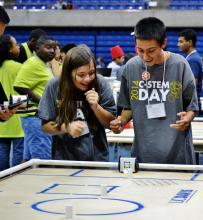UC Davis C-STEM Center
Impact
Formal evaluations suggest that the program increases student interest and achievement in computing, robotics and STEM. Student participants are 33% Hispanic, 20% Asian, 19% Caucasian, 14% multi-racial, 9% African-American, 4% Pacific Islander, and 2% American Indian. The annual RoboPlay competitions on C-STEM Day are designed to engage underperforming students and schools, who regularly win or place alongside high achieving students. The C-STEM program can significantly increase math performance and close the achievement gap for at-risk and gifted students alike. The success stories of using C-STEM program to close the math achievement gap, including helping ALL students in an Algebra 1 class with 84% “at-risk” students to pass the Algebra can be found here. In 2016-2017 school year, 14% more C-STEM students in Northwest Local School District in Cincinnati, Ohio scored proficient or higher on the Ohio Computer Based Assessments for Math, comparing the data from 2015-2016 school year.
Accomplished
- Need Accomplished
- Evaluation Accomplished
- Sustainability Developing
- Replication & Scalability Developing
- Partnerships Developing
- Capacity Accomplished
- Challenging & Relevant Content Accomplished
- STEM Practices Accomplished
- Inspiration Accomplished
- Under-Represented Groups Accomplished

Oh my gosh! I barely can contain myself….soooo fun! So challenging and so rewarding at the same time!
Math Teacher, Glen Edwards Middle School, California
Design Principles
The programs in this database clear a high bar. STEMworks reviewed each program against the Design Principles for Effective STEM Philanthropy. Programs must be Accomplished () across all Design Principles, or be Developing (
) in a maximum of three areas.
Overarching Principles
-
Need Accomplished
Identify and target a compelling and well-defined need.
-
Evaluation Accomplished
Use rigorous evaluation to continuously measure and inform progress towards the compelling need identified.
-
Sustainability Developing
Ensure work is sustainable.
-
Replication & Scalability Developing
Demonstrate replicability and scalability.
-
Partnerships Developing
Create high impact partnerships.
-
Capacity Accomplished
Ensure organizational capacity to achieve goals.
STEM Principles
-
Challenging & Relevant Content Accomplished
Offer challenging and relevant STEM content for the target audience.
-
STEM Practices Accomplished
Incorporate and encourage STEM practices.
-
Inspiration Accomplished
Inspire interest and engagement in STEM.
-
Under-Represented Groups Accomplished
Identify and address the needs of under-represented groups.
Program Overview
C-STEM Center aims to transform computing, science, technology, engineering, and mathematics (C-STEM) education in both formal and informal K-14 programs. The Center works with K-14 educators to integrate computer programming and robotics into STEM subjects through hands-on, personalized and collaborative learning strategies. C-STEM Center aims to transform computing, science, technology, engineering, and mathematics (C-STEM) education in both formal and informal K-14 programs. The Center works with K-14 educators to integrate computer programming and robotics into STEM subjects through hands-on, personalized and collaborative learning strategies. C-STEM Center has two key objectives: * Prompt many more females and students of color to pursue college and careers in computing and STEM-related areas. * Develop students’ ability to tackle real world, 21st-century challenges. Using cutting-edge research, the C-STEM Center and its industry partners have developed innovative, hands-on educational computing strategies in C/C++, modular robotics, and robot simulation technologies. The Center also trains STEM educators to use these innovative materials and strategies effectively. The Center focuses on Algebra topics, the gatekeeper for STEM disciplines. By making connections across the STEM disciplines, the it also helps students link regular STEM topics to real-life experiences while developing critical thinking and problem-solving skills. The C-STEM Center and its partners organize annual curriculum-based RoboPlay and Math Programming Competitions on C-STEM Day to further engage students in project-based team activities. These competitions showcase students’ accomplishments and creativity in not only math and engineering, but also in writing, art, music, and film production. In its undergraduate admission application for all UC campuses, the University of California officially recognizes participation in the C-STEM program, C-STEM student individual and team awards, and extracurricular activities as achievements that have prepared students for college and career.